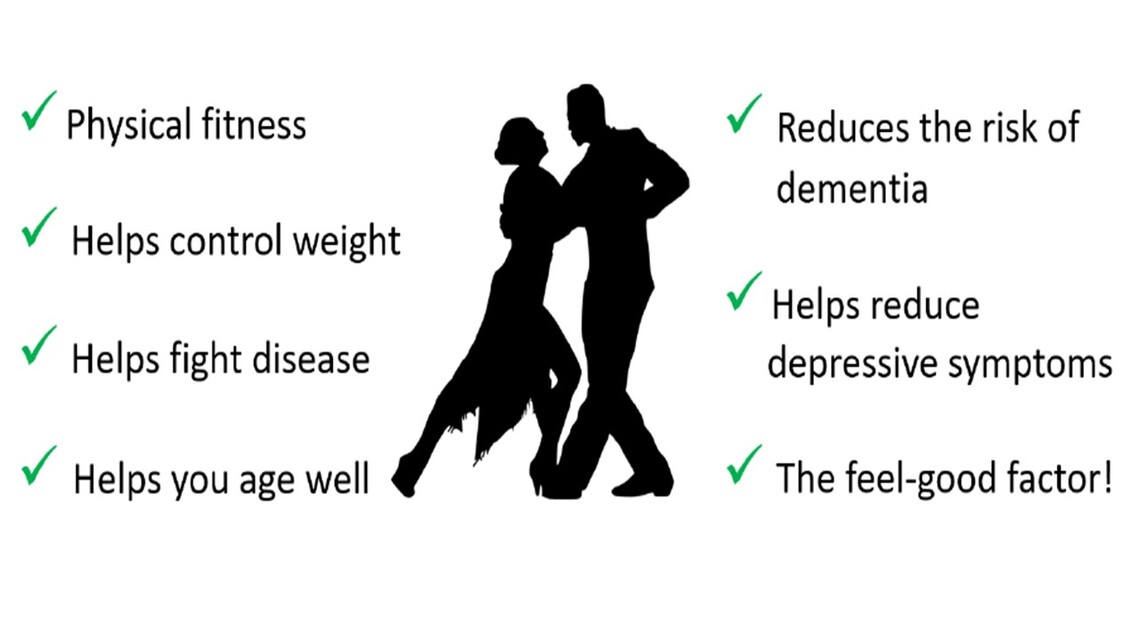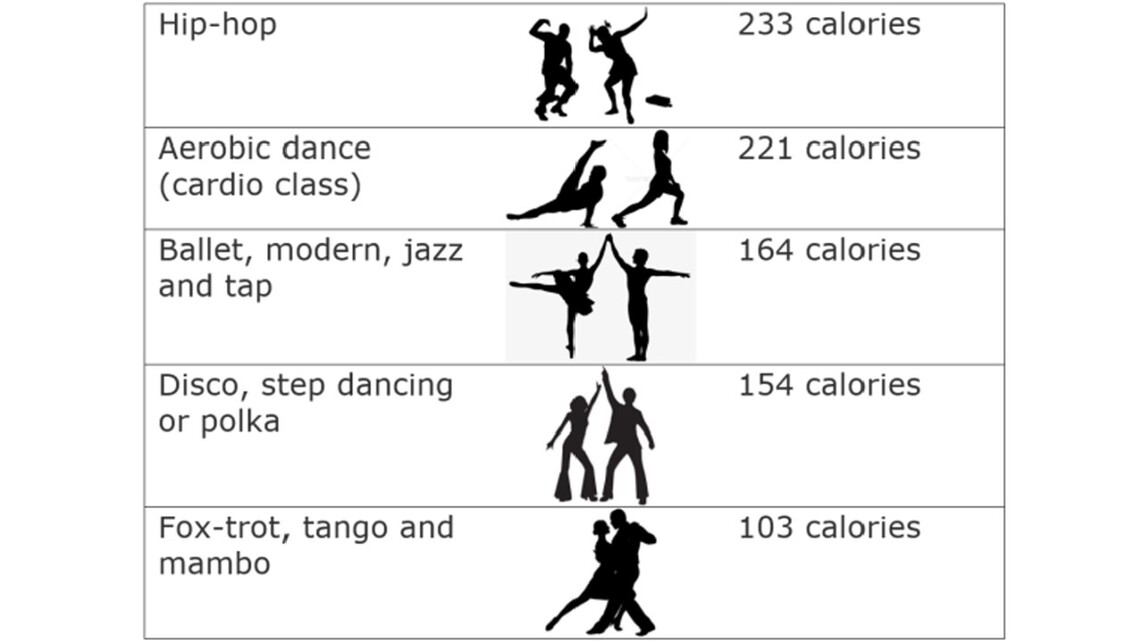- Is dance just another type of exercise – or is there something special about it?
- Can dance improve physical fitness?
- Can dance help prevent obesity?
- Can dance help fight disease?
- Can dance help you age well?
- Can dance protect against dementia?
- Can dance help with depression and stress?
- Any other benefits?
- What about Zumba dance programmes?
- But I have two left feet! I’m too old/young/unfit!
Is dance just another type of exercise – or is there something special about it?
Dance involves physical activity and so provides health benefits as a form of exercise. However, it also has some special qualities. In particular:
- It is usually something we do with other people, so it has a beneficial and enjoyable social dimension.
- Dance involves rhythmic coordination to music. Some research suggests that this rhythmic, musical element helps our immune system, and we know from experience that music can make dance more enjoyable and something we want to repeat.
- Most types of dance (from energetic disco dancing to smooth and graceful ballroom dancing) involve learning and remembering complex movements. This means that dance probably engages our brain more than most other types of exercise.

At one level, dance is a form of exercise and is therefore good for improving physical fitness. However, some types of dance are better than others for improving our level of fitness.
For example, in a small-scale study in 2010, Dr Paul Dougall at Strathclyde University found that were more agile, had stronger legs and could walk more briskly than people of the same age who took part in exercises such as swimming, walking, golf and keep-fit classes.
While a small study commissioned by the American Council for Exercise concluded that Zumba is ‘a good, high-energy aerobic workout’. Scroll down the page for more information about Zumba.
Can dance help prevent obesity?
According to a ‘diet coaching’ website fatburn.com, some dances burn off more calories than others. The website gives these average figures for a 150-pound person dancing for half an hour:
Although the effect that dancing has on weight doesn’t seem to have been studied much, burning calories like this should help you manage your weight.
Can dance help fight disease?
Regular dance sessions have also been shown to:
- lower blood fat and cholesterol levels in patients with metabolic disease (at least in a short, small scale study published in 2015).
- improve cardiovascular health for patients with chronic heart disease – according to an 8-month study published in 2013.
- improve balance, motor skills and subjective quality of life in patients with Parkinson’s – the conclusion from a 2014 review of published research findings.
- Reduce susceptibility to infection in people with Type 2 Diabetes by reducing inflammation and raising neutrophil levels to fight infections and heal damaged tissue, according to a small, short term study published in 2019.
These findings suggest that dance may help protect against the complications and disability associated with many different chronic diseases.
Can dance help you age well?
In April 2016, the BBC1 programme How to stay young reported on a small-scale study in Germany. This study found that dance was more effective in slowing ageing than going to the gym.
Dance has also been shown to reduce the physical and psychological effects of ageing, from helping to reduce the uncomfortable effects of menopause to improving gait in the elderly.
A 2015 study suggested a possible physiological mechanism in which dance achieves these effects. Regular dance was found to decrease levels of at least two inflammatory markers in the blood. This result agrees with earlier findings from neuroscience research that describe how rhythmic movements have a calming effect on the immune system, effectively calming the rate at which we age.
Can dance protect against dementia?
In 2003, the prestigious New England Journal of Medicine reported on a 21-year study of 469 people aged 75 and over in the United States. This study suggested that dance was unique among physical activities in reducing the risk of dementia, possibly by as much as 76%. This reduction was more even than reading, playing board games, doing crossword puzzles and other ways of keeping cognitively active.
We haven’t found many recent studies on dance and dementia, although two small 18-month studies were published in 2017. One study suggests that dance is more effective than fitness training in its effect on the hippocampus, the part of the brain which is important for memory consolidation and learning. Another study suggests that for older people, participating in a long-term dance programme is better than repetitive physical exercise for improving neuroplasticity (the brain’s ability to compensate for injury and disease and for adjusting to new situations or to changes in environment).
Can dance help with depression and stress?
Regular dance has been shown to reduce depressive symptoms in geriatric residents in nursing homes. It has been suggested that dance helps to improve physical fitness, which in turn helps people feel more independent and enjoy a better quality of life. Regular exposure to uplifting music also increases opportunities for socialising and enjoyment, which can help to reduce the symptoms of depression.
A second study, published in 2016, describes similar results in younger people. Regular blood analyses showed that the reduction in depressive symptoms improved mood and reduced stress and was matched by increased blood serotonin (the ‘happiness hormone’), increased endorphin (responsible for the ‘runner’s high’) and lower cortisol levels (the ‘stress hormone’).
A 2019 review of eight published studies also suggested that dance is an effective intervention in the treatment of adults with depression. However, the review did note that there was a lack of high-quality studies.
Sounds good so far; any other benefits?
Dance can help you feel good about yourself! A 2014 study looked at the effect of dancing in 283 pre-adolescent and adolescent girls. Girls who participated in regular dance-based activities for 12 months or longer had a more positive body image than their non-dancing peers. They also had higher self-esteem.
What about Zumba dance programmes?
Zumba is one of the most widely available and easily accessible forms of dance currently available in the UK. It is a Latin, dance-based workout that has grown significantly in popularity in recent years.
A number of articles have looked at the effects of Zumba on health. These have ranged from studies with young, healthy participants to older, less active and overweight participants.
Initial results suggest that as little as eight weeks of regular Zumba sessions are enough to improve participants’ aerobic fitness levels. Zumba also appears to help weight loss (an energetic, hour-long Zumba session can burn up to 600 calories), with a reduction in body fat and an increase in overall muscle mass. These are mainly short, small-scale studies, suggesting that more research is needed. However, the initial results appear promising.
At the same time Zumba can be very physically demanding on the body, so make sure that the instructor understands safe exercise techniques -to minimise the risk of injury, especially if you have any injuries or weaknesses.
But I have two left feet! I am too old/young/unfit!
Dance-based activities are widely available. They require no previous experience, no special equipment, little preparation, and not even a partner, and can be followed at home by playing a DVD. There are so many types of dance available that you should be able to find one to suit you: from ballroom to Bollywood, line dancing to disco, Morris dancing to belly dancing and many more!
Experts say that even if you think you’re not good at dancing, you can still take part as you can move at your own pace and still reap plenty of benefits.
Conclusions
- Dance provides physical activity, cognitive activity and a rhythmic response to music, usually in a social setting.
- This potentially powerful combination appears to be good for both our physical health and our mental health, while helping to slow the process of ageing.
- With so many types of dance to choose from, it’s worth a try, whatever your age, and even if you have two left feet!
|
So…shall we dance? |
______________________________
You can find other articles on keeping fit if you click on the Fitness button on our home page.
Reviewed and updated May 2020. Next review date April 2024.

